
A railroad car, railcar, railway wagon, railway carriage, railway truck, railwagon, railcarriage or railtruck, also called a train car, train wagon, train carriage or train truck, is a vehicle used for the carrying of cargo or passengers on a rail transport network. Such cars, when coupled together and hauled by one or more locomotives, form a train. Alternatively, some passenger cars are self-propelled in which case they may be either single railcars or make up multiple units.

The Southern Railway (SR) gave the designations 4-COR, 4-RES, 4-BUF and 4-GRI to the different types of electric multiple unit built to work the route between London Waterloo and Portsmouth Harbour. The 4-COR type units survived long enough in British Rail ownership to be allocated TOPS Class 404. The COR designation had previously been used for the 6-PUL units and was reused by them during World War II when the Pullman car was stored, but this stock was different from the 4-COR units.

The British Rail Class 423, electric multiple unit passenger trains were mostly built by British Rail (BR) at York Works from 1967 to 1974, although the MBSOs and TSOs of the first 20, 7701-7720, were built at Derby Works. They have manually opening doors next to every seating row and were the last coaching stock built in this pattern for BR. They were mostly found working outer-suburban services in South London and rural services in Kent, Sussex and Hampshire, up to 2005 when they were finally replaced by Electrostar and Desiro units. The fleet had a working life of 38 years.
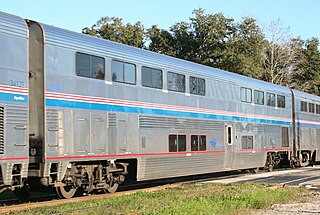
A passenger railroad car or passenger car, also called a passenger carriage, passenger coach, or passenger bogie is a railroad car that is designed to carry passengers, usually giving them space to sit on train seats. The term passenger car can also be associated with a sleeping car, a baggage car, a dining car, railway post office and prisoner transport cars.
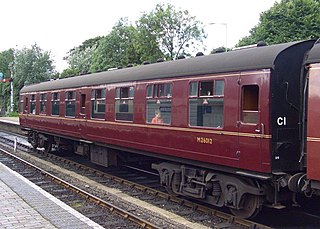
The Second Corridor type of railway carriage was one of the standard mid-20th century designs, and was coded SK by the LNER and BR, and CF by the LMS. The layout of the coach was a number of compartments, all of which were second class, linked by a side corridor.
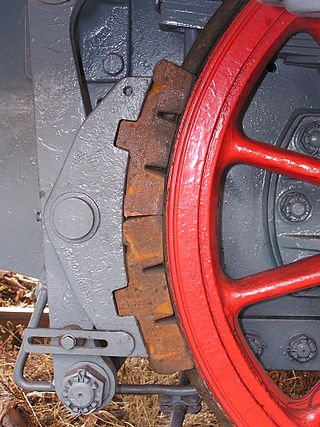
A railway brake is a type of brake used on the cars of railway trains to enable deceleration, control acceleration (downhill) or to keep them immobile when parked. While the basic principle is similar to that on road vehicle usage, operational features are more complex because of the need to control multiple linked carriages and to be effective on vehicles left without a prime mover. Clasp brakes are one type of brakes historically used on trains.
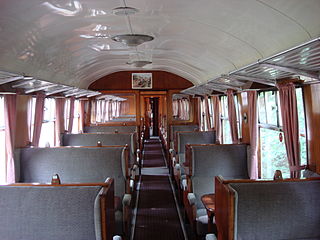
British Rail Mark 1 is the family designation for the first standardised designs of railway carriages built by British Railways (BR) from 1951 until 1974, now used only for charter services on the main lines or on preserved railways.

The British Rail Mark 3 is a type of passenger carriage developed in response to growing competition from airlines and the car in the 1970s. A variant of the Mark 3 became the rolling stock for the High Speed Train (HST).
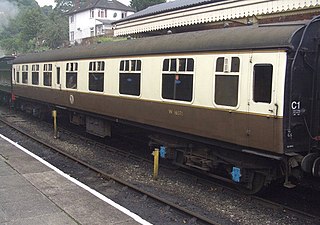
The Composite Corridor is a railway coach with a number of compartments, some of which are standard class and some first class, linked by a side corridor.
Push–pull is a configuration for locomotive-hauled trains, allowing them to be driven from either end of the train, whether having a locomotive at each end or not.

The British Rail Class 415 was a suburban 750 V DC third rail electric multiple unit commissioned by the Southern Region of British Railways. Built between 1951 and 1957, it became the most numerous class on the region after the withdrawal of the 4SUBs. The final trains were withdrawn in the 1990s, replaced by Class 455, 456, 465 and 466.
The Night Ferry was an international boat train from London Victoria to Paris Gare du Nord that crossed the English Channel on a train ferry. It ran from 1936 until 1939 when it ceased due to the onset of World War II. It resumed in 1947, ceasing in 1980. It was operated by Compagnie Internationale des Wagons-Lits until 1977 and then British Rail.

The S type carriages are a corridor-type passenger carriage used on the railways of Victoria, Australia. The first carriages were constructed by the Victorian Railways in 1937 for use on the Spirit of Progress, with additional carriages built for other trains until the mid-1950s.
The London and North Eastern Railway (LNER) inherited several styles of coaching stock from its constituents. Sir Nigel Gresley continued the styles that he had established pre-grouping at the Great Northern Railway (GNR) and for the East Coast Joint Stock.

The passenger coaches of the Great Western Railway (GWR) were many and varied, ranging from four and six-wheeled vehicles for the original broad gauge line of 1838, through to bogie coaches up to 70 feet (21 m) long which were in service through to 1947. Vacuum brakes, bogies and through-corridors all came into use during the nineteenth century, and in 1900 the first electrically lit coaches were put into service. The 1920s saw some vehicles fitted with automatic couplings and steel bodies.
The Bluebell Railway is a heritage line West Sussex and East Sussex in England.

A gangway connection is a flexible connector fitted to the end of a railway coach, enabling passengers to move between coaches without danger of falling from the train.

The Southern Railway Maunsell carriage was the first design family of railway carriages built by Richard Maunsell for the Southern Railway (SR) in the United Kingdom. Following grouping in 1923, SR had continued to build carriages to the designs of the previous three main companies, and the Maunsell carriage was intended to be the standard carriage design for use across the Southern Railway lines, incorporating the best features of each of the former companies' designs.
This page outlines the history and evolution of Victorian Railways (Australia) bogie passenger carriages, constructed with steel underframes and timber bodies up to 59 ft 9 in (18.21 m) long, as well as a few other carriages from the era.
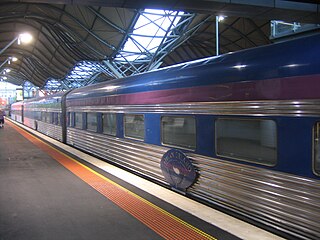
The first passenger cars built specifically for The Overland train service operated by the Victorian and South Australian Railways (V & SAR) were introduced in 1949. By the end of 1951, eight new sleeping cars and six new sitting cars had entered service. Additions to the fleet continued until 1972; in all, 44 carriages were built. About eight were still in service as of 2024 on The Overland operated by Journey Beyond. Other carriages have been transferred to different services or sold.
















